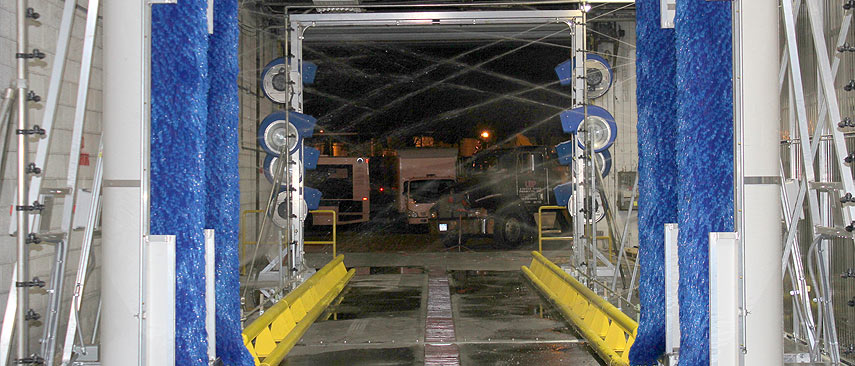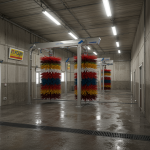As the trucking industry continues to grow and evolve, so too must the systems that keep these massive vehicles clean and roadworthy. Enter the brush gantry system, a powerful and efficient solution for washing 18-wheelers and other large vehicles. But with new advancements in truck technology and safety features, can these systems keep up with the demands of tomorrow’s trucks? In this article, we’ll take a closer look at the future of truck washing and explore the potential of brush gantry systems to meet the needs of the modern trucking industry. From improved efficiency to enhanced safety features, we’ll examine the latest trends and innovations in truck washing technology, and explore the challenges and opportunities that lie ahead for truck wash operators and fleet managers alike. So buckle up and get ready to explore the exciting world of truck washing in 2023 and beyond!
The current state of truck washing
Before we can explore the future of truck washing, it’s important to understand the current state of the industry. Today, most truck washes use brush gantry systems to clean large vehicles. These systems typically consist of a gantry that moves back and forth over the truck, with brushes that scrub the vehicle clean. While these systems are effective at removing dirt and grime, they do have their limitations. For instance, they can cause damage to the truck’s paint and bodywork, and they may not be able to reach certain areas of the vehicle, such as the roof or undercarriage.
Despite these limitations, brush gantry systems remain the most popular option for truck washing due to their low cost and high efficiency. However, as technology continues to evolve, there are new solutions emerging that may offer a better way to clean large vehicles.
Limitations of brush gantry systems for 18-wheelers
While brush gantry systems have been the go-to solution for washing 18-wheelers and other large vehicles for many years, they do have their limitations. One of the biggest challenges with these systems is that they can cause damage to the truck’s paint and bodywork. The brushes used in these systems are designed to scrub away dirt and grime, but they can also scratch the paint or even dent the vehicle’s bodywork.
Another challenge with brush gantry systems is that they may not be able to reach certain areas of the vehicle, such as the roof or undercarriage. This can be a problem for fleet managers who need to ensure that their trucks are thoroughly cleaned to meet safety and regulatory requirements.
The rise of touchless truck washing technology
To address the limitations of brush gantry systems, a new technology has emerged known as touchless truck washing. This system uses high-pressure water jets and specialized detergents to clean the vehicle, without the need for brushes or physical contact. The result is a more thorough and efficient clean, with less risk of damage to the truck’s paint and bodywork.
Touchless truck washing technology has been around for some time but has only recently gained popularity in the trucking industry. As more fleet managers look for ways to improve the safety and efficiency of their operations, touchless truck washing has become an increasingly attractive option.
Advantages of touchless truck washing systems
There are several advantages to using touchless truck washing systems. One of the biggest benefits is that they can clean a truck more thoroughly than brush gantry systems. Because there is no physical contact between the vehicle and the washing equipment, there is less risk of damage to the truck’s paint and bodywork. Additionally, touchless systems can reach areas of the vehicle that are difficult or impossible to clean with brush gantry systems, such as the roof and undercarriage.
Another advantage of touchless truck washing systems is that they are more environmentally friendly than brush gantry systems. Because they use less water and fewer chemicals, touchless systems have a lower impact on the environment. This is a major selling point for fleet managers who are looking to reduce their carbon footprint and promote sustainability.
The future of truck washing technology
As technology continues to evolve, there are new innovations emerging in the world of truck washing. One of the most exciting developments is the use of robotics and automation to clean large vehicles. This technology uses sensors and cameras to scan the truck, identify areas that need to be cleaned, and then deploy robotic arms to wash those areas. This approach offers a more precise and efficient clean, with less risk of damage to the vehicle.
Another trend in truck washing technology is the use of water recycling systems. These systems capture and filter water that is used during the washing process, allowing it to be reused for subsequent washes. This not only reduces water usage but also helps to reduce costs and promote sustainability.
Innovations in truck washing systems
In addition to robotics and water recycling, there are other exciting innovations emerging in the world of truck washing. For instance, some companies are developing truck washing systems that use electromagnetic waves to clean the vehicle. These systems are designed to break down dirt and grime at the molecular level, leaving the truck clean and shiny without the need for brushes or physical contact.
Another area of innovation is in the development of specialized detergents and cleaning agents. These products are designed to be more effective at removing dirt and grime from trucks, while also being gentle on the vehicle’s paint and bodywork. As these products become more widely available, we can expect to see increased adoption of touchless truck washing systems.
Benefits of upgrading to touchless truck washing systems
For fleet managers and truck wash operators, upgrading to touchless truck washing systems can offer several benefits. One of the biggest advantages is that these systems can improve the safety and efficiency of their operations. With less risk of damage to the truck’s paint and bodywork, there is less need for repairs and maintenance, which can save time and money in the long run.
Another benefit of touchless truck washing systems is that they can help to promote sustainability. By using less water and fewer chemicals, these systems have a lower impact on the environment, which is becoming increasingly important to consumers and regulators alike.
Challenges facing the adoption of touchless truck washing technology
Despite the many benefits of touchless truck washing technology, there are still some challenges facing its adoption. One of the biggest obstacles is the cost of upgrading to these systems. While touchless systems can be more efficient and cost-effective in the long run, the initial investment can be significant, which may deter some fleet managers from making the switch.
Another challenge is that touchless truck washing systems require specialized equipment and training. This can be a barrier for smaller truck wash operators who may not have the resources to invest in these systems.
Conclusion
As the trucking industry continues to grow and evolve, so too must the systems that keep these massive vehicles clean and roadworthy. While brush gantry systems have been the go-to solution for washing 18-wheelers and other large vehicles for many years, there are new technologies emerging that may offer a better way to clean these trucks. From touchless truck washing to robotics and water recycling, the future of truck washing is bright and full of exciting possibilities. While there are still challenges facing




